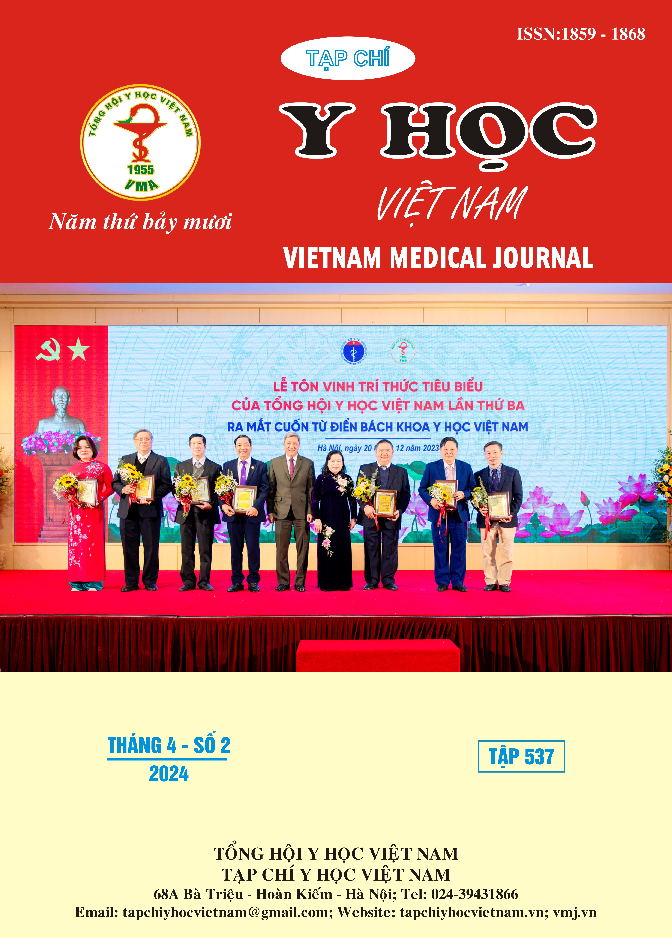SỬ DỤNG VẠT BÌ CẲNG TAY NGOÀI CUỐNG NGOẠI VI CHE PHỦ KHUYẾT HỔNG MÔ MỀM CỔ BÀN TAY: BÁO CÁO MỘT SỐ CA LÂM SÀNG
Nội dung chính của bài viết
Tóm tắt
Đặt vấn đề: Các khuyết hổng mô mềm vùng cổ, bàn tay thường dễ lộ các cấu trúc quí, nên cần phải che phủ sớm bằng vật liệu tốt. Trước đây vạt da cân cẳng tay quay cuống ngoại vi (vạt Trung Quốc) thường được sử dụng rộng rãi để che phủ vùng này. Tuy nhiên việc dùng vạt Trung Quốc có hai bất lợi là phải hi sinh động mạch quay (ĐMQ) và để lại sẹo xấu. Một lựa chọn khác để che phủ vùng cổ, bàn tay là vạt da cân thần kinh bì cẳng tay ngoài cuống ngoại vi (VBCTN) với ưu điểm như: không phải hy sinh ĐMQ, chất liệu che phủ tốt, tin cậy và có thể che phủ diện lớn. Nhưng các dữ liệu lâm sàng của VBCTN chưa nhiều. Do vậy, đòi hỏi cần phải có một nghiên cứu để đánh giá kết quả của VBCTN trong che phủ các khuyết hổng mô mềm ở cổ tay, bàn tay. Đối tượng và phương pháp nghiên cứu: Thiết kế nghiên cứu: báo cáo hàng loạt ca, tiến cứu. 8 bệnh nhân với 8 vạt da bì cẳng tay ngoài được thiết để che phủ các khuyết hổng mô mềm vùng cổ bàn tay lộ gân, xương, tại Khoa Vi phẫu – Tạo hình, Bệnh viện Chấn thương chỉnh hình Thành phố Hồ Chí Minh từ tháng 9/2020 đến tháng 9/2022. Bệnh nhân được theo dõi ít nhất là 2 tháng, để đánh giá tình trạng vạt da. Kết quả: Tất cả các vạt da đều sống. Tuy nhiên có 1 trường hợp hoại tử mép da và 1 trường hợp bị ứ máu tĩnh mạch dẫn đến hoại tử lớp nông đầu xa của vạt da, tuy vậy vết thương lành hoàn toàn sau 20 ngày chăm sóc. Nơi cho vạt: 5 bệnh nhân được đóng da trực tiếp, 3 bệnh nhân còn lại phải ghép da mỏng. Kích thước vạt lớn 7 x8 cm. Vạt da có thể che phủ nhiều vị trí vùng cổ bàn tay, bờ quay (3 trường hợp), mặt mu tay (2 trường hợp), lòng bàn tay (2 trường hợp), mặt trước cổ tay (1 trường hợp). Không có bệnh nhân nào than đau kiểu u thần kinh hay than phiền các khiếm khuyết về cảm giác. Bàn luận: VBCTN sử dụng trong che phủ các khuyết hổng mô mềm vùng cổ bàn tay có độ tin cậy cao. Vạt có thể thiết kế với kích thước lớn. Vạt bóc tách dễ dàng, đáng tin và linh động, không phải hy sinh các mạch máu lớn như ĐM quay, ĐM trụ và ĐM gian cốt sau. Trong đa số các trường hợp, nơi cho vạt có thể đóng kín ngay thì đầu
Chi tiết bài viết
Từ khóa
vạt bì cẳng tay ngoài, nhánh xuyên động mạch quay, tĩnh mạch đầu
Tài liệu tham khảo
2. Weinzweig N, Chen L., Chen ZW. (1994) "The distally based radial forearm fasciosubcutaneous flap with preservation of the radial artery: an anatomic and clinical approach". Plast Reconstr Surg, 94 (5), pp.675-84.
3. Chertif C, Georgescu AV (2009) "Cutaneous Vascular Territories of the Forearm and Hand". TMJ, 59 (3), pp.241-246.
4. Dedes CR, Morris SF, Neligan P (2003) "Perforator flaps: evolution, classification, and applications". Ann Plast Surg, 50, 90-99.
5. El-Khatib H, Zeidan M (1997) "Island adipofascial flap based on distal perforators of the radial artery: an anatomic and clinical investigation". Plast Reconstr Surg, 100 (7), pp. 1762-6.
7. Nguyễn Anh Tuấn (2004) "Một số nhận xét về các vạt da cuống ngoại vi vùng cẳng tay trong che phủ mất da bàn tay". Y học Thành Phố Hồ Chí Minh, tập 8 (1), tr. 47-50.
6. Nguyễn Tấn Bảo Ân (2015), " Nghiên cứu giải phẫu ứng dụng vạt da cân thần kinh bì cẳng tay ngoài cuống ngoại vi". Luận văn tốt nghiệp Bác sỹ Nội Trú . tr 50-58
8. Beldner S, Jones MH. (2005) "Anatomy of the lateral antebrachial cutaneous and superficial radial nerves in the forearm: a cadaveric and clinical study". J Hand Surg Am, 30 (6), pp. 1226-30.


